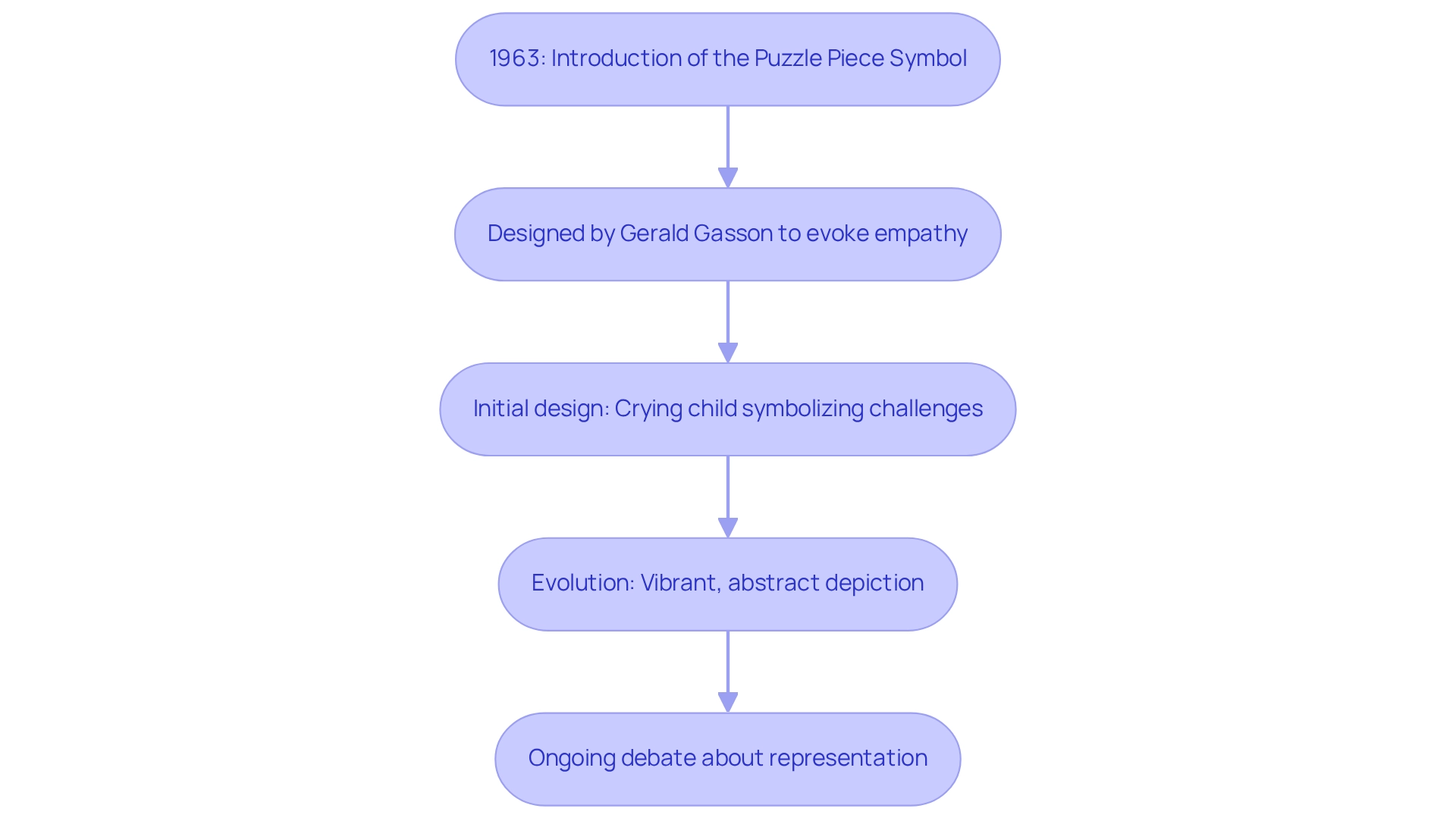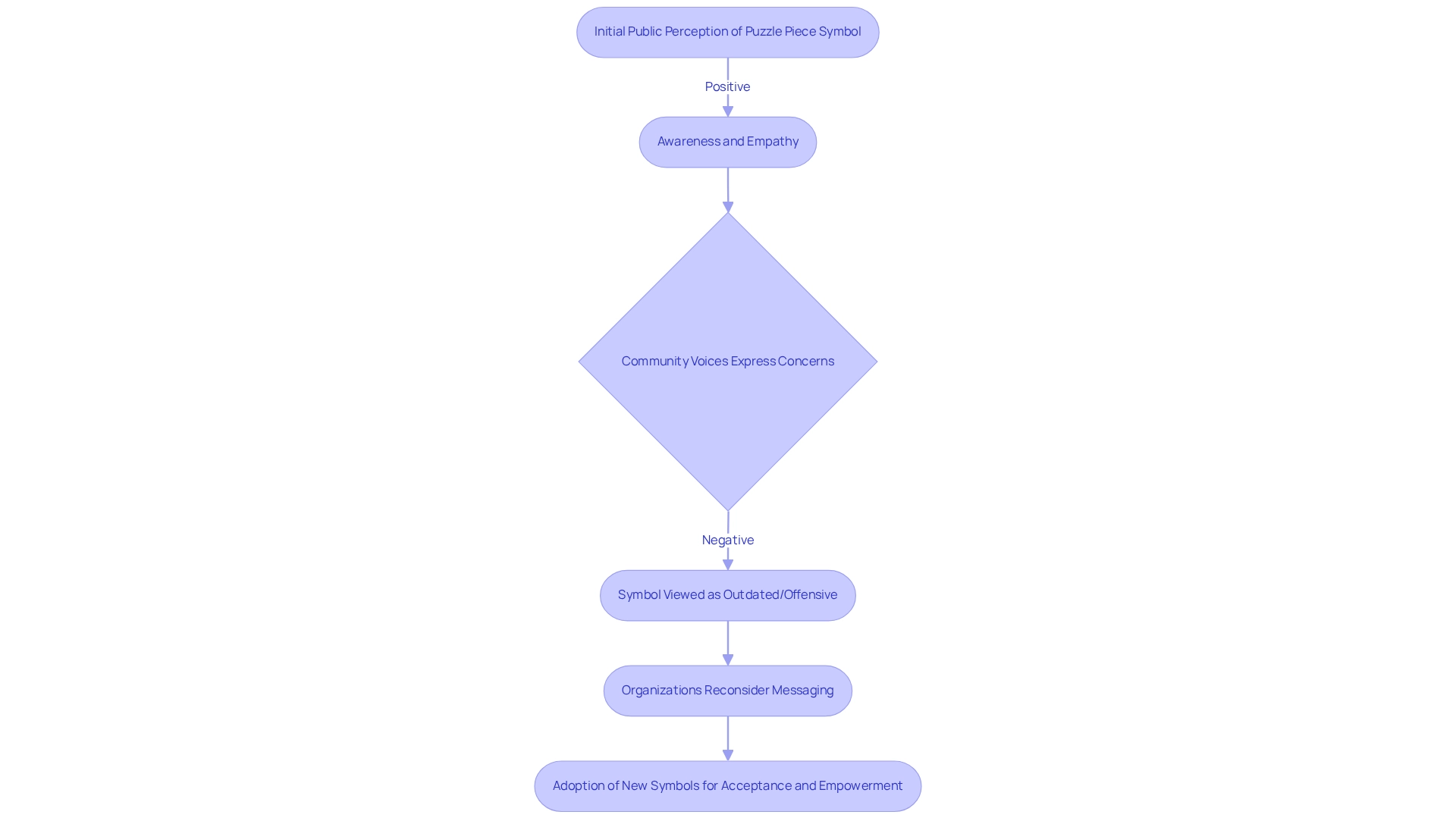Overview
The puzzle piece symbol, often associated with autism advocacy, originated in the 1960s as a representation of the complexity of autism. However, it has faced significant criticism for suggesting that autistic individuals are incomplete or lacking. This criticism, deeply rooted in the voices of the autistic community, has sparked a movement towards alternative symbols, such as the infinity sign. These new symbols better reflect the diversity and strengths of those on the spectrum, promoting a more inclusive narrative that resonates with many.
As parents and advocates, it’s essential to recognize the emotional weight behind these symbols. The shift towards more representative imagery not only honors the experiences of autistic individuals but also fosters a sense of belonging and acceptance. By embracing symbols that celebrate the unique qualities of those on the spectrum, we can contribute to a more supportive and understanding environment.
Let’s engage in this conversation together. What symbols or representations have resonated with you or your loved ones? Share your thoughts and experiences in the comments, as we continue to advocate for a narrative that uplifts and empowers everyone in the autism community.
Introduction
The puzzle piece symbol, once a beacon of awareness for autism, has become a focal point of debate and re-evaluation in recent years. Initially designed to encapsulate the complexities of autism, its implications have sparked significant controversy. Many advocates argue that it perpetuates harmful stereotypes of incompleteness, which can leave individuals feeling marginalized.
As the autism advocacy landscape evolves, a growing movement is emerging, favoring symbols that celebrate diversity and inclusivity, such as the infinity symbol. This shift not only reflects a deeper understanding of the autistic experience but also underscores the urgent need for representations that empower rather than alienate.
Exploring the historical origins, criticisms, and the transition to alternative symbols reveals a critical dialogue about identity, acceptance, and the future of autism advocacy. As we navigate this important conversation, it’s essential to consider how we can support individuals and families in finding symbols that resonate with their experiences and foster a sense of belonging.
Explore the Historical Origins of the Puzzle Piece Symbol
The puzzle representation first emerged in 1963, introduced by the National Autistic Society in the UK. Created by Gerald Gasson, a devoted parent of a child with developmental differences, this puzzle piece symbol was designed to illustrate the complexity and mystery surrounding autism. Initially, the puzzle piece symbol featured a crying child, a poignant image intended to evoke empathy and raise awareness about the challenges faced by autistic individuals.
As time progressed, the design evolved; the weeping child was replaced by a more vibrant and abstract depiction that includes the puzzle piece symbol, symbolizing the diversity of the autism spectrum. Yet, the original intent of the puzzle piece symbol—to highlight the difficulties associated with the condition—continues to spark debate in contemporary discussions about its representation. Understanding this evolution is crucial for fostering a more compassionate dialogue around autism and its many facets.

Examine Criticisms and Controversies of the Puzzle Piece Symbol
The implications of the puzzle piece symbol have undergone significant scrutiny due to its impact on individuals with autism-related conditions. Many advocates express concern that it conveys a sense of incompleteness, suggesting that individuals on the spectrum are 'missing' something vital. This framing not only reinforces harmful stereotypes but also overlooks the unique strengths and contributions of those on the spectrum. Notably, this emblem was created without the input of autistic individuals, leading to feelings of alienation and misrepresentation within the community.
Moreover, the association of the puzzle piece with organizations like Autism Speaks, which has faced criticism for its advocacy approach, has further tarnished its reputation. A case study titled 'Ableism and Stigmatization of the Puzzle Piece Symbol' illustrates how the puzzle piece symbol frames autism as a problem to be resolved, rather than acknowledging it as a valid neurodivergent identity. As we move into 2025, public sentiment reveals a growing dissatisfaction with this representation, as many seek alternatives that promote acceptance and inclusivity. For instance, the infinity sign has emerged as a favored representation, reflecting the diversity and complexity inherent in the spectrum of neurodiversity.
Statistics indicate that gold symbolizes the distinctive strengths and abilities of individuals on the autism spectrum, bolstering the argument against the puzzle motif. Case studies highlight the negative impact of the puzzle piece symbol on public perception, with many individuals on the spectrum reporting that it perpetuates ableism and stigmatization. Research by Morton Ann Gernsbacher suggests that such imagery should be avoided, reinforcing the call for a reevaluation of the representations used in advocacy for individuals on the spectrum. As the movement towards neurodiversity gains momentum, the need for representations that honor the diversity of neurodivergent identities becomes increasingly urgent. It is essential to reflect on the symbols we choose in advocacy to ensure they foster acceptance and inclusivity for everyone on the spectrum.
Understand the Shift to Alternative Symbols in Autism Advocacy
In recent years, we have witnessed a heartening shift towards alternative representations that truly reflect the vibrant autistic community. Take the infinity sign, for example; it has blossomed in popularity as it embodies the concept of limitless possibilities and the diverse experiences within autism. Often paired with a spectrum of colors, this symbol beautifully illustrates diversity and acceptance.
Similarly, representations like the butterfly highlight transformation and the beauty found in diversity. This evolution signals a growing recognition of the need for empowering representations that uplift rather than stigmatize. It aligns with the broader goals of advocacy, fostering understanding and acceptance in our communities.
As we continue this journey, let’s embrace these symbols and advocate for a world where every individual feels valued and understood.
Analyze the Impact of the Puzzle Piece Symbol on Public Perception and Advocacy
The puzzle piece symbol representation has significantly influenced societal perceptions of autism. Initially, it was a powerful tool for raising awareness and fostering empathy. Yet, as voices within the autistic community began to express their concerns, the representation of the puzzle piece symbol started to be viewed as outdated and even offensive. This shift has prompted organizations and advocates to reconsider their messaging and the symbols they choose to represent autism.
The negative associations tied to the puzzle piece symbol have sparked a broader conversation about the vital role of representation in advocacy efforts. Consequently, many organizations are now embracing symbols that embody the values of acceptance, diversity, and empowerment. They aim to cultivate a more inclusive narrative around autism, inviting everyone to join in this important journey toward understanding and support.

Conclusion
The historical journey of the puzzle piece symbol illustrates the complexities surrounding autism representation. Initially intended to evoke empathy and raise awareness, this symbol has faced criticism, with many arguing that it perpetuates harmful stereotypes of incompleteness. Such framing overlooks the strengths and unique identities of individuals on the autism spectrum, leaving many feeling marginalized and misrepresented.
As advocacy continues to evolve, there is an urgent need for alternative symbols, such as the infinity symbol, which signifies a growing recognition of inclusivity and empowerment. These new representations celebrate the diversity and complexity of autism, aligning with broader goals of acceptance and understanding within the community. Transitioning to symbols that resonate positively with autistic individuals reflects a vital dialogue about identity and belonging.
Ultimately, the conversation surrounding autism advocacy and its symbols is crucial for fostering a more inclusive narrative. By embracing representations that uplift rather than alienate, society can support individuals and families in their journey, ensuring that all voices are heard and valued. The future of autism advocacy lies in symbols that acknowledge challenges while celebrating the rich tapestry of experiences within the autistic community.
Frequently Asked Questions
When did the puzzle representation first emerge?
The puzzle representation first emerged in 1963, introduced by the National Autistic Society in the UK.
Who created the puzzle piece symbol and why?
The puzzle piece symbol was created by Gerald Gasson, a devoted parent of a child with developmental differences, to illustrate the complexity and mystery surrounding autism.
What was the original design of the puzzle piece symbol?
The original design featured a crying child, intended to evoke empathy and raise awareness about the challenges faced by autistic individuals.
How has the design of the puzzle piece symbol evolved over time?
Over time, the design evolved from the weeping child to a more vibrant and abstract depiction that includes the puzzle piece symbol, representing the diversity of the autism spectrum.
What is the ongoing debate regarding the puzzle piece symbol?
The original intent of the puzzle piece symbol—to highlight the difficulties associated with autism—continues to spark debate in contemporary discussions about its representation.
Why is understanding the evolution of the puzzle piece symbol important?
Understanding the evolution of the puzzle piece symbol is crucial for fostering a more compassionate dialogue around autism and its many facets.




